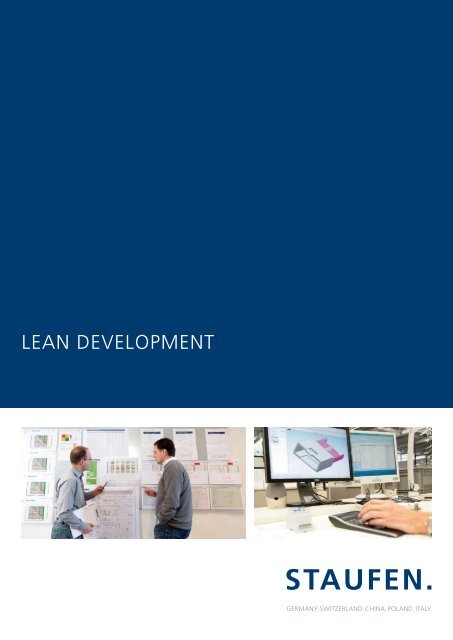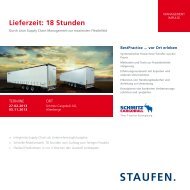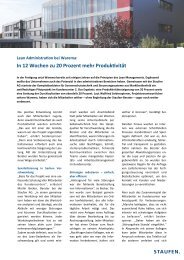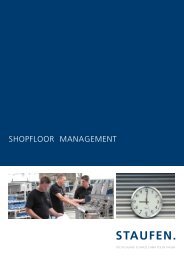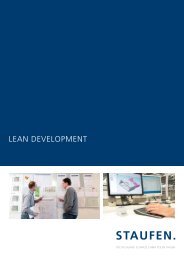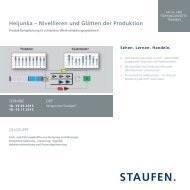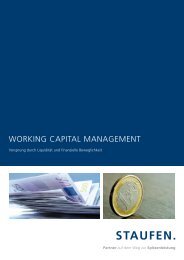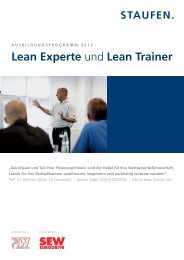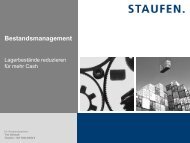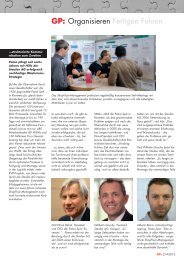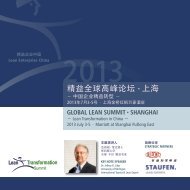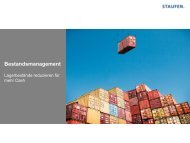Brochure Lean Development - Staufen
Brochure Lean Development - Staufen
Brochure Lean Development - Staufen
You also want an ePaper? Increase the reach of your titles
YUMPU automatically turns print PDFs into web optimized ePapers that Google loves.
LEAN DEVELOPMENT<br />
GERMANY. SWITZERLAND. CHINA. POLAND. ITALY
Focussing on the essential.<br />
LEADERS IN INNOVATION AND PERFORMANCE DEVELOP LEANER<br />
companies AND GET their products TO THE MARKET QUICKER.<br />
<strong>Lean</strong> <strong>Development</strong> reduces lead times in the product creation process through the elimination<br />
of waste. A <strong>Lean</strong> <strong>Development</strong> System uses lean principles, based on organisational and operational<br />
methods with the aim of takt-timing development projects efficiently and securing their<br />
results.<br />
These days, complex products are the result of complex development<br />
processes. Competition and market conditions condense<br />
the life cycles of products as well as the ‘time-to-money’.<br />
These challenges cannot be mastered by troubleshooting - the<br />
demands made on modern development organizations have<br />
undergone a fundamental change. At the same time, innovation<br />
and product development represent the most effective<br />
levers for securing lasting corporate success. Minimizing waste<br />
coupled with flexibility and breathability of the development<br />
organization are the starting points whole productivity potentials<br />
can be unlocked to good effect.<br />
The logic of a lean production system can lead to the coherent<br />
development of a product creation process based on minimized<br />
lead times.<br />
1. Absence of faults = robust processes thanks to the widespread<br />
use of standards, FMEA together with immediate clarification in<br />
case of fault and problems during the early stages of a project<br />
2. Flow = continuous communication of development results from<br />
initial customer specifications to the start of series production<br />
3. Rhythm = takt-timing of projects and work packages by project<br />
clarification prior to project start, stringent project control and<br />
short-cycle regular communication<br />
4. Pull = pull principle at the interfaces - information and decisionmaking<br />
is called in by the next downstream processors as required<br />
Transparency and focus instead of authorization to read and a<br />
flood of information<br />
Mentor-mentee dialogue instead of hierarchy and micromanagement<br />
Frontloading instead of resource overloading<br />
Value-stream orientation instead of functional thinking
Orientation on capacity utilisation<br />
(conventional approach)<br />
Orientation on lead times<br />
(LEAN DEVELOPMENT approach)<br />
>> Functional organisation<br />
>> Sequential process<br />
>> Push<br />
>> Full utilization of resources<br />
>> Numerous parallel projects<br />
with changing priorities<br />
>> Shortest possible lead times<br />
>> Value stream oriented<br />
>> Pull / Flow<br />
>> Flexibility through resource<br />
management<br />
>> Staggered projects<br />
The main focus in lean development is on<br />
minimizing lead time together with<br />
increasing efficiency and effectiveness<br />
through waste reduction.<br />
The LEAN DEVELOPMENT system comprises<br />
7 action areas which unlock potentials in<br />
respect of costs, quality, delivery service and<br />
sustainability.<br />
1_ Strategy: Strategically direct your core competences as well as<br />
your development competences towards future-oriented and innovative<br />
product areas.<br />
2_ Technology management: Define coordinated pre-development<br />
and product roadmaps in order to safeguard quality as well as the<br />
level of innovation.<br />
3_ Value-stream organization: Orientation of the organization at<br />
the value stream ensures that all departments involved in the product<br />
creation process contribute towards the projects in the best possible<br />
way, in terms of expertise as well as of time. The predecessorsuccessor<br />
relations within a development project are seen as internal<br />
customer-supplier relations. Negative multitasking is avoided through<br />
segmentation of the organization, i.e. the separation of organizational<br />
units according to main competences/ tasks or respectively time<br />
management in accordance with work packages/ main activities.<br />
4_ Process orientation and frontloading: At the start of the project,<br />
an interdisciplinary approach is used to bring together as much<br />
information on the project tasks as possible in the requirement specifications,<br />
to prioritize and schedule development stages. Risks and<br />
prophylactic measures together with technical properties are recorded<br />
in the product specifications.<br />
5_ Project management and focus on bottlenecks: A bottleneck in<br />
a development system constitutes the resource determining its takttime.<br />
In order to ensure optimum control of a multi-project scenario,<br />
bottlenecks have to be identified and stripped of unnecessary tasks.<br />
The multiproject set-up is then oriented by the bottleneck resource<br />
using prioritization and the staggered dispatching of the individual<br />
projects. A bottleneck resource is always supplied with prioritized<br />
work packages and in case of problems receives full support from its<br />
line management.<br />
6_ Leadership and communication: The timely control of multiple<br />
projects requires regular communication with reactive measures to<br />
deviations, a structured approach to problem solving and the optimum<br />
use of resources. The focus in this is on leadership and decisionmaking<br />
at the actual site of the problem based on transparent visualization<br />
of project progress and actions.<br />
7_ Product design: Based on the inclusion of design guidelines in requirement<br />
and product specifications, products compliant with production,<br />
supply and logistics requirements are defined as target values<br />
- thus avoiding costs and waste in the long term.<br />
Advantages and benefits thanks to<br />
<strong>Lean</strong> <strong>Development</strong><br />
Sustainable reduction in lead times as the result of simultaneous<br />
and interdisciplinary work<br />
Increased project throughput for the same team<br />
Faster reaction times, fault reduction and increased adherence<br />
to schedules<br />
Greater efficiency in communication resulting from a drastic<br />
reduction in unsystematic communication<br />
Optimized use of resources and bottleneck competences
SUCCESSFUL COMPANIES AND<br />
GOOD CUSTOMERS.<br />
Our experts work for renowned companies:<br />
Aerotech Peissenberg GmbH & Co. KG<br />
Albrecht Jung GmbH & Co. KG<br />
Bosch-Siemens Hausgeräte GmbH<br />
ILLIG Maschinenbau GmbH & Co. KG<br />
Infineon Technologies AG<br />
SEW-EURODRIVE GmbH & Co.<br />
Siemens AG<br />
Theben AG<br />
Knowledge makes you smart,<br />
implementation lean.<br />
„Absence of waste and excellence in the development<br />
process are the basis for shortening our project<br />
processes and increasing the reliability of our promises<br />
to external and internal customers.“<br />
Dr. T. Achim Oberacker<br />
Director R&D<br />
Theben AG<br />
<strong>Lean</strong> development,<br />
faster market launch<br />
Competitive advantages<br />
through <strong>Lean</strong> <strong>Development</strong><br />
Stuttgart: LOG_X 2010<br />
ISBN 978-3-932298-42-4<br />
49 EUR plus p&p<br />
Wir beraten Sie gerne.<br />
Wie Sie Shopfloor Managementin Ihrem Unternehmen<br />
umsetzen<br />
STAUFEN.AG<br />
STAUFEN.AG<br />
können.<br />
Beratung.Akademie.Beteiligung<br />
Blumenstraße 5<br />
Seidenstrasse 27<br />
Welcher D-73257 Köngen Nutzen für Sie rechenbar CH-8400 Winterthur wird.<br />
+49 7024 8056-0<br />
+49 7024 8056-111<br />
+41 52 316 3768<br />
Welchen Erfolg Sie realisieren werden.<br />
www.staufen.ag<br />
kontakt@staufen.ag<br />
Beratung.Akademie.Beteiligung<br />
+41 52 316 3759<br />
www.staufen.ag<br />
contact.ch@staufen.ag<br />
STAUFEN.shanghai<br />
Consulting Academy Ltd.<br />
22 H, Cross Region Plaza<br />
No. 899 Ling Ling Road<br />
Shanghai, 200030 P.R. China<br />
+86 21 64 41 71 12 /-16 /-15<br />
+86 21 64 41 71 05<br />
www.staufen.cn<br />
shanghai@staufen.cn<br />
STAUFEN.ITALIA srl<br />
Consulenza.Formazione.Investimenti<br />
largo Richini 6<br />
I-20161 Milano<br />
+39 02 58 215 346<br />
+39 02 58 215 400<br />
www.staufen.it<br />
contatti@staufen.it<br />
STAUFEN.POLSKA<br />
Doradztwo.Akademia.Inwestycje Sp. z o.o<br />
il. sw. Mikolaja 7<br />
PL-50-125 Wroclaw<br />
+48 71 3 561 274<br />
+48 71 3 561 275<br />
www.staufen.pl<br />
kontakt@staufen.pl


